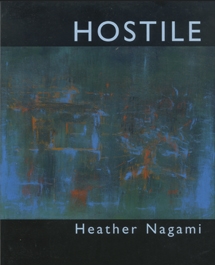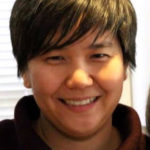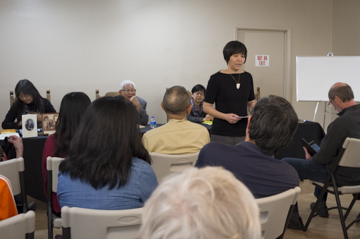Tucson poet Heather Nagami is Yonsei (4th generation Japanese American), and her Sansei mother Toshiko Edna Togawa was born in Poston Relocation Center, near Parker, Arizona. Poston was one of the largest of the WWII Japanese American internment camps, housing 18,000 civilians.
These excerpts were read by Heather at the Feb. 17, 2017 Day of Remembrance (of E.O. 9066) at the Tucson Desert Art Museum. Two are re-published here by permission of Heather and can be found in her book “Hostile” by Chax Press, 2005. More info about Heather at her website: www.heathernagami.com. Her mother Toshiko was present for this reading of nine poems of “Acts of Translation.”
“III. Figure 10.30. Classroom building at the Poston I elementary school.
Since no arrangements had been made, evacuees built their own classrooms.
“But mom didn’t know if there was going to be one where we were going.”
West of Blocks 19 and 30.
“So, she brought encyclopedias for us and for the other children.”
Sufficient lumber was not available, so they leveled the ground.
“Only one suitcase, you know?”
The others brought bedding, toilet articles, eating utensils and clothing. Walls were created of adobe, a foreign material to most.
“You see how your grandma is? Even back then.”
Mixed mud for bricks, lined hundreds to dry in 115-degree heat. Figure 10.13.
Pouring foundation for school. Which still stands today.”
________
IV. Daughter
Figure ten point. ten point. and they couldn’t?
Intergenerational tension was also a major problem in the relocation centers, especially since Issei and Nisei were very distinct generations.
This book says, “Intergenerational tension was also a major… since Issei and Nisei were very… The majority of Issei leadership had… du da da dah… Pearl Harbor… Nisei gained power and… Once the…
However, use of the Japanese language was restricted: meetings… in English… publications… in English…”
Meetings. Meetings. And publications. What were. But then how did? I don’t think this is…
But auntie spoke going in, didn’t speak going out.
And you, born there, never spoke. Here it says, “meetings.” What is “meetings”?
I don’t think they let grandma speak to
speak to you, when you were born
speak “gohan”
speak
“hashi”
like you
spoke
to me
How did grandma
speak
How did
grandma
speak
how to distinguish shiokarai from karai?
What words, what, what, English? Shiokarai. Salty? Strong, biting taste, like shoyu? No, like, like, soy sauce, right? And karai is, is “hot”, like, like, hot like wasab No, no, like, horseradish. Don’t eat that. Hot, like horseradish.”
__________
3 exhibits with photography, art and artifacts on the WWII Japanese American internment camps are ongoing at the Tucson Desert Art Museum, 7000 E. Tanque Verde Rd. until April 30, 2017. Some of Heather’s works are included in this exhibit.




Powerful.
Yes indeed, and interesting interface between generations and language learning of immigrants and their descendants. We went through that as well, and I’ve forgotten most of the Japanese I learned from my grandparents.